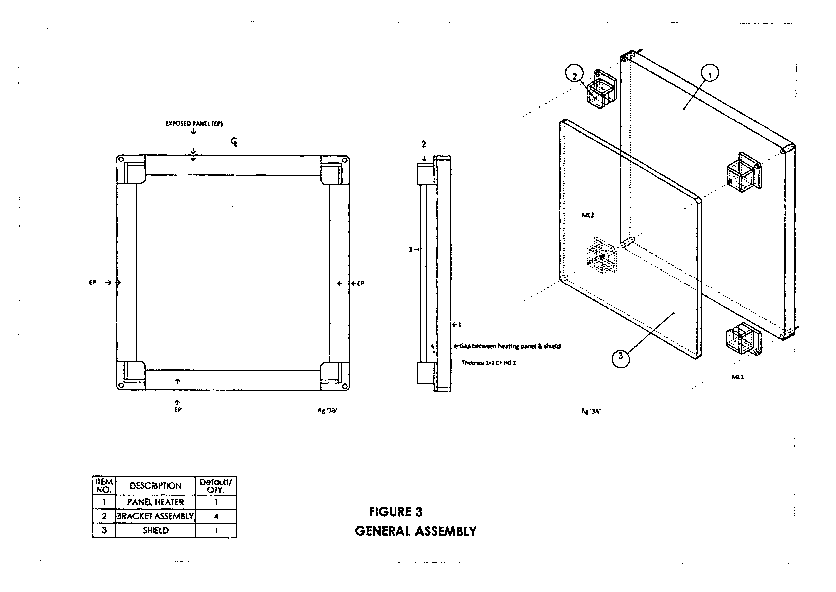Une partie des informations de ce site Web a été fournie par des sources externes. Le gouvernement du Canada n'assume aucune responsabilité concernant la précision, l'actualité ou la fiabilité des informations fournies par les sources externes. Les utilisateurs qui désirent employer cette information devraient consulter directement la source des informations. Le contenu fourni par les sources externes n'est pas assujetti aux exigences sur les langues officielles, la protection des renseignements personnels et l'accessibilité.
L'apparition de différences dans le texte et l'image des Revendications et de l'Abrégé dépend du moment auquel le document est publié. Les textes des Revendications et de l'Abrégé sont affichés :
| (12) Demande de brevet: | (11) CA 2960586 |
|---|---|
| (54) Titre français: | NOUVEAU PROCEDE DE PROTECTION DE SURFACE CHAUDE ET D'AMELIORATION DE PANNEAUX CHAUFFANTS |
| (54) Titre anglais: | NOVEL METHOD OF SHIELDING HOT SURFACE AND IMROVING PANEL HEATERS |
| Statut: | Réputée abandonnée et au-delà du délai pour le rétablissement - en attente de la réponse à l’avis de communication rejetée |
| (51) Classification internationale des brevets (CIB): |
|
|---|---|
| (72) Inventeurs : |
|
| (73) Titulaires : |
|
| (71) Demandeurs : |
|
| (74) Agent: | |
| (74) Co-agent: | |
| (45) Délivré: | |
| (86) Date de dépôt PCT: | 2015-09-15 |
| (87) Mise à la disponibilité du public: | 2016-03-24 |
| Requête d'examen: | 2017-03-16 |
| Licence disponible: | S.O. |
| Cédé au domaine public: | S.O. |
| (25) Langue des documents déposés: | Anglais |
| Traité de coopération en matière de brevets (PCT): | Oui |
|---|---|
| (86) Numéro de la demande PCT: | PCT/IN2015/000358 |
| (87) Numéro de publication internationale PCT: | IN2015000358 |
| (85) Entrée nationale: | 2017-03-08 |
| (30) Données de priorité de la demande: | ||||||
|---|---|---|---|---|---|---|
|
La présente invention concerne un nouveau procédé de protection de surface chaude et de perfectionnement de panneaux chauffants (1). Ledit procédé se rapporte à un nouveau système d'écran de protection comprenant un écran (3) et des pièces d'angle (2) qui non seulement recouvrent la surface chaude des panneaux chauffants (1) mais facilitent également un second chemin de courants de convection pour chauffer l'espace par maintien d'un espace de courant optimal.
Novel method of shielding hot surface and improving panel heaters (1). The method relates to new system of shield comprising of shield (3) and corner pieces (2) that not only cover the hot surface of panel heaters (1) but also facilitates second path of convection currents for space heating by maintaining optimum current space.
Note : Les revendications sont présentées dans la langue officielle dans laquelle elles ont été soumises.
Note : Les descriptions sont présentées dans la langue officielle dans laquelle elles ont été soumises.

2024-08-01 : Dans le cadre de la transition vers les Brevets de nouvelle génération (BNG), la base de données sur les brevets canadiens (BDBC) contient désormais un Historique d'événement plus détaillé, qui reproduit le Journal des événements de notre nouvelle solution interne.
Veuillez noter que les événements débutant par « Inactive : » se réfèrent à des événements qui ne sont plus utilisés dans notre nouvelle solution interne.
Pour une meilleure compréhension de l'état de la demande ou brevet qui figure sur cette page, la rubrique Mise en garde , et les descriptions de Brevet , Historique d'événement , Taxes périodiques et Historique des paiements devraient être consultées.
| Description | Date |
|---|---|
| Demande non rétablie avant l'échéance | 2018-09-17 |
| Le délai pour l'annulation est expiré | 2018-09-17 |
| Réputée abandonnée - omission de répondre à un avis sur les taxes pour le maintien en état | 2017-09-15 |
| Inactive : Page couverture publiée | 2017-08-16 |
| Lettre envoyée | 2017-04-11 |
| Inactive : Notice - Entrée phase nat. - Pas de RE | 2017-03-22 |
| Inactive : CIB en 1re position | 2017-03-17 |
| Demande reçue - PCT | 2017-03-17 |
| Inactive : CIB attribuée | 2017-03-17 |
| Exigences relatives à une correction d'un inventeur - jugée conforme | 2017-03-17 |
| Inactive : Correspondance - PCT | 2017-03-16 |
| Exigences pour une requête d'examen - jugée conforme | 2017-03-16 |
| Toutes les exigences pour l'examen - jugée conforme | 2017-03-16 |
| Requête d'examen reçue | 2017-03-16 |
| Déclaration du statut de petite entité jugée conforme | 2017-03-08 |
| Exigences pour l'entrée dans la phase nationale - jugée conforme | 2017-03-08 |
| Demande publiée (accessible au public) | 2016-03-24 |
| Date d'abandonnement | Raison | Date de rétablissement |
|---|---|---|
| 2017-09-15 |
| Type de taxes | Anniversaire | Échéance | Date payée |
|---|---|---|---|
| Taxe nationale de base - petite | 2017-03-08 | ||
| Requête d'examen - petite | 2017-03-16 |
Les titulaires actuels et antérieures au dossier sont affichés en ordre alphabétique.
| Titulaires actuels au dossier |
|---|
| VANGALA, PATTABHI |
| Titulaires antérieures au dossier |
|---|